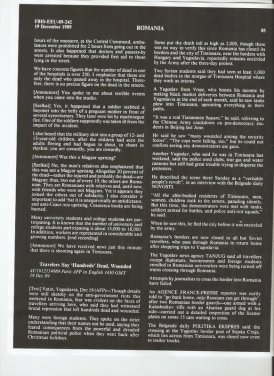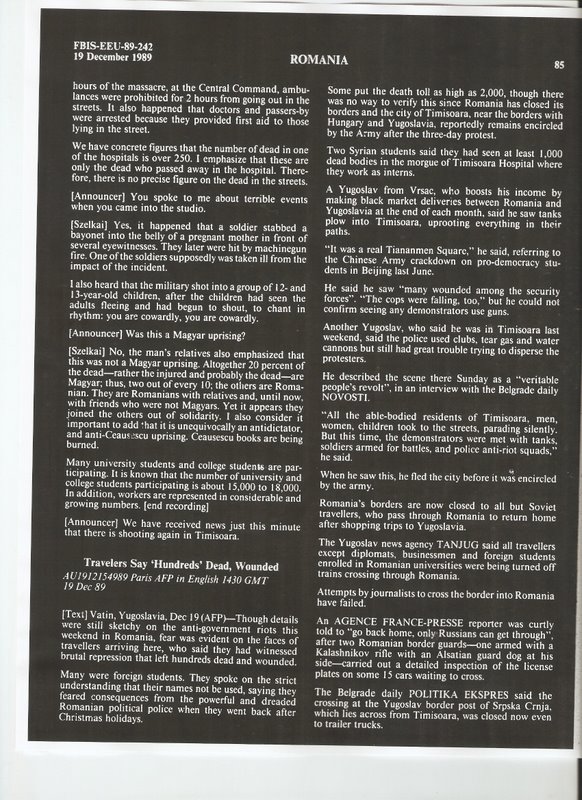Final Boarding Call for TAROM’s special ROMBAC service from Bucuresti to Sibiu: Would the large party of suspicious “Soviet tourists” please report to the gate immediately! (III)
Posted by romanianrevolutionofdecember1989 on August 14, 2013

http://atomic-temporary-3899751.wpcomstaging.com/a-response-to-watts-ii-preliminary/
PARTS 1 AND 2
In the last episode, I discussed how high-level local and national Securitate officers were unable to find a foreign role in the Timisoara unrest, even though Nicolae Ceausescu and Securitate Director Iulian Vlad explicitly instructed them to find such a link (indicatii pretioase from top to bottom).
Larry Watts maintains that “Ceausescu protested the sudden influx of Soviet “tourists” to Moscow at the time, none of whom stayed in hotels. See e.g. Mircea Munteanu, New Evidence on the 1989 Crisis in Romania, e-Dossier no. 5, Washington D.C., Woodrow Wilson International Center for Scholars, December 2001, pp. 3-11, CWIHP.” (With Friends Like These, 2010, p. 26 (endnote #26)
Let us look, however, at how Mircea Munteanu himself characterized these documents:
The following documents show the attempts of the Romanian regime to maintain secrecy
on the events taking place in Romania— even with regard to its increasingly estranged Soviet ally.
From restricting the access of Russian tourists in Romania beginning with 18 December (footnote 4)
(Document No. 1) to the demands made by the Romanian embassy in Moscow to the Soviet
leadership to prevent the Soviet media from publishing news reports about “alleged events”
taking place in Timisoara, Cluj and, later, Bucharest (Documents Nos. 4 and 5), Bucharest sought
to limit the damage to the regime’s image of stability. Afraid that information about the events
taking place in Romania would tarnish Ceausescu’s image of “a world leader,” the Foreign
Ministry instructed the Romanian embassies not to respond to any questions concerning the
“alleged” events and demanded that all actions taken by the Romanian government were
legitimate by virtue of its sovereignty. (Document No. 2).
The documents also present a picture of a regime grasping at straws, accusing even
former allies of conspiracy, and believing that isolation would insure its survival. Ceausescu’s
longstanding hysteria about the machinations of “foreign espionage agencies” — and his growing
mistrust towards Soviet leader Mikhail Gorbachev— reached new heights in his accusation that
turmoil in Romania was used by the Warsaw Pact to oust him (Ceausescu) from office, a
suggestion that struck Aboimov as utter “insanity.” (Documents Nos. 5 and 7). Quite the
contrary, the US-Soviet conversations suggest, was actually the case.
footnote #4:
There were persistent rumors, during and after the 1989 events in Romania that the Soviet KGB sent numerous agents in Romania in December 1989. Some accounts accused the KGB of attempting to destabilize the regime while others accused them of attempting to shore it up. Likely both accounts are somewhat exaggerated. While it is clear that the KGB was interested in obtaining information about the events, it is unlikely that it attempted to interfere, either way in the unfolding of the events. It is more likely that the closing of the borders both with the USSR but also with Hungary and Yugoslavia, is likely that stranded numerous transistors on Romanian territory.
http://www.wilsoncenter.org/sites/default/files/e-dossier5.pdf
Significantly, then, there is no mention of “Ceausescu protesting a sudden influx Soviet “tourists” to Moscow at the time.” Instead, as Munteanu discusses, the access of Soviet citizens to Romania was restricted beginning 18 December 1989–Munteanu speculates, in part to “maintain secrecy on the events taking place in Romania,” and in part because of Ceausescu’s longstanding hysteria about the machinations of “foreign espionage agencies” (that this was Ceausescu’s suspicion and mindset is clear; that it had a genuine basis in reality is not–as even his leading Securitate officers dispatched to Timisoara were to admit (http://atomic-temporary-3899751.wpcomstaging.com/2013/04/29/high-time-to-unpack-already-why-the-restless-journey-of-the-soviet-tourists-of-the-romanian-revolution-should-come-to-an-end/)
It is also worth looking at exactly what is written in the documents from this E-dossier. Here is an important excerpt from Romania’s Ambassador to Moscow, Ion Bucur:
—————————————————————————————————————
The critical passage of Ion Bucur’s dispatch above is probably the following: “I suggested that some temporary measures were adopted due to the need to limit access of certain groups of tourists [in the country]. [Those limitats were imposed] due to difficulties in assuring their access to hotel rooms and other related essential conditions. Those limitations do not apply to business travel or tourists transiting Romania.”
I have written on this subject several times in the past, for example here http://www.rferl.org/content/article/1342503.html
DECEMBER 1989: NICOLAE CEAUSESCU INITIATES THE ‘TOURIST’ MYTH
Not surprisingly, the “tourist” myth originated with none other than Nicolae Ceausescu. This myth inevitably implies illegitimate and cynical “foreign intervention,” and Ceausescu used it to make sense of what were — probably genuinely, for him — the unimaginable and surreal antiregime protests which began in Timisoara on 15 December 1989.
In an emergency meeting of the Romanian equivalent of the politburo (CPEX) on the afternoon of Sunday, 17 December 1989 — the afternoon on which regime forces were to open fire on the anti-Ceausescu demonstrators in Timisoara, killing scores and wounding hundreds — Ceausescu alleged that foreign interference and manipulation were behind the protests:
“Everything that has happened and is happening in Germany, in Czechoslovakia, and in Bulgaria now, and in the past in Poland and Hungary, are things organized by the Soviet Union with American and Western help” (cited in Bunea, 1994, p. 34).
That Ceausescu saw “tourists” specifically playing a nefarious role in stimulating the Timisoara protests is made clear by his order at the close of this emergency meeting:
“I have ordered that all tourist activity be interrupted at once. Not one more foreign tourist will be allowed in, because they have all turned into agents of espionage…. Not even those from the socialist countries will be allowed in, with the exception of [North] Korea, China, and Cuba. Because all the neighboring socialist countries are untrustworthy. Those sent from the neighboring socialist countries are sent as agents” (cited in Bunea, 1994, p. 34).
A CHRONOLOGY OF THE ‘TOURISTS’ ITINERARY AND ACTIVITIES ACCORDING TO TOP SECURITATE AND PARTY OFFICIALS IN THE IMMEDIATE AFTERMATH OF DECEMBER 1989
Filip Teodorescu, who as head of the Securitate’s Counterespionage Directorate (Directorate III) had been dispatched to Timisoara and was later arrested for his role in the repression there, maintained in March 1990 at his trial that he detained “foreign agents” during the Timisoara events (“Romania libera,” 9 March 1990). In a book that appeared in 1992, Teodorescu described as follows the events in Timisoara on Monday, 18 December — that is, after the bloody regime repression of anti-Ceausescu demonstrators the night before:
“There were few foreigners in the hotels, the majority of them having fled the town after lunch [on 17 December] when the clashes began to break out. The interested parties remained. Our attention is drawn to the unjustifiably large number of Soviet tourists, be they by bus or car. Not all of them stayed in hotels. They either had left their buses or stayed in their cars overnight. Border records indicate their points of entry as being through northern Transylvania. They all claimed they were in transit to Yugoslavia. The explanation was plausible, the Soviets being well-known for their shopping trips. Unfortunately, we did not have enough forces and the conditions did not allow us to monitor the activities of at least some of these ‘tourists'” (Teodorescu, 1992, p. 92).
Teodorescu appears here to be attempting to account for the fact that on Monday, 18 December 1989 — presumably as a consequence of Ceausescu’s tirade the afternoon before about the malicious intent of virtually all “tourists” — Romania announced, in typically Orwellian fashion, that it would not accept any more tourists because of a “shortage of hotel rooms” and because “weather conditions are not suitable for tourism” (Belgrade Domestic Service, 20 December 1989). Ironically, the only ones exempted from this ban were “Soviet travelers coming home from shopping trips to Yugoslavia” (!) (AFP, 19 December 1989)…
One must also ask: If it was precisely Soviet tourists who were most suspected at the time of being up to no good in the country, then why was it precisely they who were the sole group among “tourists” in the country at the time to be permitted to stay and go about their business unhindered?
Bucur’s statement was corroborated by press reporting at the time:
FBIS-EEU-89-242 (19 December 1989), p. 85. Paris AFP in English 1430 GMT 19 December 1989.
Vatin, Yugoslavia, Dec. 19 (AFP)
Romania’s borders are now closed to all but Soviet travellers, who pass through Romania to return home after shopping trips to Yugoslavia….
An AGENCE FRANCE PRESSE reporter was curtly told to “go back home, only Russians can get through,” after two Romanian border guards–one armed with a Kalashnikov rifle with an Alsatian guard dog at his side–carried out a detailed inspection of the license plates on some 15 cars waiting to cross.
I have been using this source since back in the 1990s when I wrote my dissertation (defended December 1996) at Indiana University (Bloomington), but I still get a kick out of it when I come across it–particularly in light of the seemingly never-ending, snowballing revisionism which alleges that the Timisoara uprising was sparked by “Soviet tourists” or “Russian tourists,” etc.
18-19 December 1989: The Timisoara Crackdown in Ceausescu’s Absence
Considering the centrality of the “foreign tourist” scenario to Securitate-inspired accounts of the December events, it is interesting to note the actions taken by the Ceausescu regime on 18 December 1989. At the close of the emergency CPEx meeting on Sunday afternoon, Nicolae Ceausescu had announced:
I have ordered that all tourist activity be interrupted at once. Not one more foreign tourist will be allowed in, because they have all turned into agents of espionage….Not even those from the socialist countries will be allowed in, outside of [North] Korea, China, and Cuba. Because all the neighboring socialist countries are untrustworthy. Those sent from the neighboring socialist countries are sent as agents.[5]
On Monday, 18 December 1989, in typical Ceausist-style it was therefore announced that Romania would not accept any more tourists because of a “shortage of hotel rooms” and because “weather conditions” were “not suitable for tourism.”[6] Ironically, the only ones exempted from this ban were: “Soviet travellers coming home from shopping trips to Yugoslavia”(!)[7]
excerpt from http://atomic-temporary-3899751.wpcomstaging.com/rewriting-the-revolution-1997-chapter-6-18-22-december-1989/

Final Boarding Call for TAROM’s special ROMBAC service from Bucuresti to Sibiu: Would the large party of suspicious “Soviet tourists” please report to the gate immediately! (IV) « The Romanian Revolution of December 1989 said
[…] Final Boarding Call for TAROM’s special ROMBAC service from Bucuresti to Sibiu: Would the large pa… […]
Larry Watts: Ce ştia Ceauşescu despre “turiştii” sovietici. Revoluţia română din decembrie 1989 (IV): Evaluarea „celor mai bune dovezi“ – publicat de Victor RONCAEA in Ziaristi Online - RadioMetafora.ro said
[…] El insistă că Ceauşescu a fost pur şi simplu paranoic şi susţine că, din moment ce „Ceauşescu a ordonat nu doar ca turiştii sovietici, dar ca toţi turiştii, din est şi din vest“ să fie opriţi, dictatorul nu era îngrijorat în mod deosebit de prezenţa „turiştilor“ sovietici. (Hall, despre turiştii sovietici #1) […]